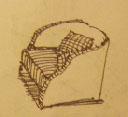?昨天在smth,有人問起RegisterClass函數到底將窗口類注冊到哪里了,想了一下,應該是一個系統級的存儲空間里,但是卻沒有一個明確的說法,msdn上看了半天,基本上沒有提到具體注冊的位置。倒是返回值給了不少提示,ATOM,查ATOM終于找到如下的一段描述
?The system provides a number of atom tables. Each atom table serves a different purpose. For example, dynamic data exchange (DDE) applications use the global atom table to share item-name and topic-name strings with other applications. Rather than passing actual strings, a DDE application passes global atoms to its partner application. The partner uses the atoms to obtain the strings from the atom table.
Applications can use local atom tables to store their own item-name associations.
The system uses atom tables that are not directly accessible to applications. However, the application uses these atoms when calling a variety of functions. For example, registered clipboard formats are stored in an internal atom table used by the system. An application adds atoms to this atom table using the RegisterClipboardFormat function. Also, registered classes are stored in an internal atom table used by the system. An application adds atoms to this atom table using the RegisterClass or RegisterClassEx function.
也就是說應該在一個原子表中,于是google之,終于找到一片像樣的文章。轉貼如下:
What's the atom returned by RegisterClass useful for?
The RegisterClass and RegisterClassEx functions return an ATOM. What is that ATOM good for?
The names of all registered window classes is kept in an atom table internal to USER32. The value returned by the class registration functions is that atom. You can also retrieve the atom for a window class by asking a window of that class for its class atom via GetClassWord(hwnd, GCW_ATOM).
The atom can be converted to an integer atom via the MAKEINTATOM macro, which then can be used by functions that accept class names in the form of strings or atoms. The most common case is the lpClassName parameter to the CreateWindow macro and the CreateWindowEx function. Less commonly, you can also use it as the lpClassName parameter for the GetClassInfo and GetClassInfoEx functions. (Though why you would do this I can't figure out. In order to have the atom to pass to GetClassInfo in the first place, you must have registered the class (since that's what returns the atom), in which case why are you asking for information about a class that you registered?)
To convert a class name to a class atom, you can create a dummy window of that class and then do the aforementioned GetClassWord(hwnd, GCW_ATOM). Or you can take advantage of the fact that the return value from the GetClassInfoEx function is the atom for the class, cast to a BOOL. This lets you do the conversion without having to create a dummy window. (Beware, however, that GetClassInfoEx's return value is not the atom on Windows 95-derived operating systems.)
But what good is the atom?
Not much, really. Sure, it saves you from having to pass a string to functions like CreateWindow, but all it did was replace a string with with an integer you now have to save in a global variable for later use. What used to be a string that you could hard-code is now an atom that you have to keep track of. Unclear that you actually won anything there.
I guess you could use it to check quickly whether a window belongs to a particular class. You get the atom for that class (via GetClassInfo, say) and then get the atom for the window and compare them. But you can't cache the class atom since the class might get unregistered and then re-registered (which will give it a new atom number). And you can't prefetch the class atom since the class may not yet be registered at the point you prefetch it. (And as noted above, you can't cache the prefetched value anyway.) So this case is pretty much a non-starter anyway; you may as well use the GetClassName function and compare the resulting class name against the class you're looking for.
In other words, window class atoms are an anachronism. Like replacement dialog box classes, it's one of those generalities of the Win32 API that never really got off the ground, but which must be carried forward for backwards compatibility.
But at least now you know what they are.
最終的結論,RegisterClass應該是將窗口類的數據放在User32.dll維護的一個原子表中了:)
?
本文來自CSDN博客,轉載請標明出處:http://blog.csdn.net/Hamxj/archive/2007/05/09/1601758.aspx




